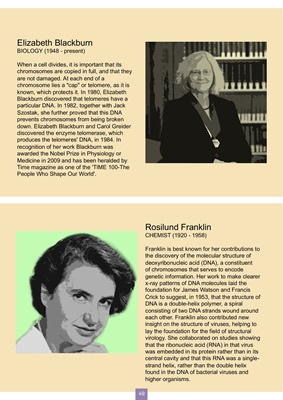
Elizabeth Blackburn
BIOLOGY (1948 - present)
When a cell divides, it is important that its
chromosomes are copied in full, and that they
are not damaged. At each end of a
chromosome lies a "cap" or telomere, as it is
known, which protects it. In 1980, Elizabeth
Blackburn discovered that telomeres have a
particular DNA. In 1982, together with Jack
Szostak, she further proved that this DNA
prevents chromosomes from being broken
down. Elizabeth Blackburn and Carol Greider
discovered the enzyme telomerase, which
produces the telomeres' DNA, in 1984. In
recognition of her work Blackburn was
awarded the Nobel Prize in Physiology or
Medicine in 2009 and has been heralded by
Time magazine as one of the 'TIME 100-The
People Who Shape Our World'.
Rosilund Franklin
CHEMIST (1920 - 1958)
Franklin is best known for her contributions to
the discovery of the molecular structure of
deoxyribonucleic acid (DNA), a constituent
of chromosomes that serves to encode
genetic information. Her work to make clearer
x-ray patterns of DNA molecules laid the
foundation for James Watson and Francis
Crick to suggest, in 1953, that the structure of
DNA is a double-helix polymer, a spiral
consisting of two DNA strands wound around
each other. Franklin also contributed new
insight on the structure of viruses, helping to
lay the foundation for the field of structural
virology. She collaborated on studies showing
that the ribonucleic acid (RNA) in that virus
was embedded in its protein rather than in its
central cavity and that this RNA was a singlestrand
helix, rather than the double helix
found in the DNA of bacterial viruses and
higher organisms.
49